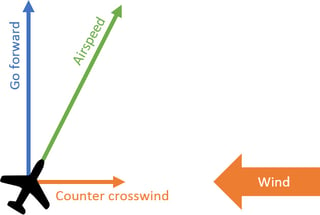From your question, it appears that you may have some misconceptions.
Thrust is forward. It controls the airspeed, which is also related to the angle of attack. Crosswind is wind blowing either left-to-right or right-to-left. Therefore, thrust and crosswind are unrelated; auto-thrust will not compensate for crosswind because thrust can only make the plane go faster/slower or go up/down, but crosswind blows side to side.
If your question is whether the autopilot uses asymmetrical thrust to control the plane in these conditions, then the answer is no: thrust is not responsive enough to control a plane's attitude, asymmetrical thrust is only used in emergency situations when no other options are available.
My bet is you're asking about gusts and wind shear, which can be experienced as either a headwind, tailwind or crosswind, so it may affect an aircraft's airspeed. Wind shear is defined as a sudden change of wind speed and/or wind direction.
The calculated speed of a landing is called Vref. In a normal landing, the pilots usually input Vref+5 into the autopilot. In gusty conditions, the pilots may input Vref+10 into the autopilot. A less flap setting may also be selected, again for the purpose of flying the approach at a higher airspeed. A higher airspeed is desired because it increases the stall margin.
When using the autothrottle, position command speed to VREF + 5 knots.
Sufficient wind and gust protection is available with the autothrottle
connected because the autothrottle is designed to adjust thrust
rapidly when the airspeed drops below command speed while reducing
thrust slowly when the airspeed exceeds command speed. In turbulence,
the result is that average thrust is higher than necessary to maintain
command speed. This results in an average speed exceeding command
speed.
If a manual landing is planned with the autothrottle connected
in gusty or high wind conditions, consider positioning the command
speed to VREF + 10 knots. This helps protect against a sudden loss of
airspeed during the flare.
quote from Boeing 777 Flight Crew Training Manual
Auto-thrust itself is precise enough to handle gusty winds to an extent, but it has its limitations. IIRC using auto-thrust is recommended in these scenarios, as it reduces the pilots' workload in a challenging situation. Plane manufacturers and airline companies often have limitations regarding the maximum gust / maximum crosswind. Attempting a landing outside these limitations may exceed the auto-thrust's capability to respond to rapid airspeed changes; it may also exceed the landing gear's strength or the wing's loading and therefore is dangerous.

